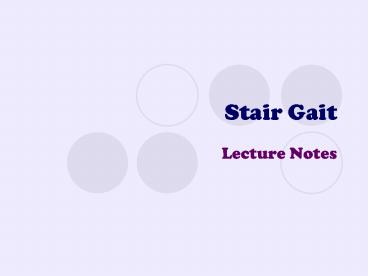Stair Gait - PowerPoint PPT Presentation
Title:
Stair Gait
Description:
Stair Gait Lecture Notes Stair Gait Stair climbing is a general type of motion, because it involves an angular motion in the joints & a translatory movement of the ... – PowerPoint PPT presentation
Number of Views:249
Avg rating:3.0/5.0
Title: Stair Gait
1
Stair Gait
- Lecture Notes
2
Stair Gait
- Stair climbing is a general type of motion,
because it involves an angular motion in the
joints a translatory movement of the whole
body. - Stair gate is similar to level-ground gait
- They both involve swing stance phases
- Progression of the body is done by alternating
movement of lower extremities - Lower extremities must balance and carry HAT
(head, arms, trunk) - Like walking, in stair climbing we have a time
when both feet are touching the steps. One foot
on the first step the other on the second step
3
Stair Gait
- Stair gate is different than level-ground gait
- The firs thing we put on the stair is the
anterior portion of the foot, unlike in level
walking where posterior portion of the foot
(heel) is put first on the ground - The subphases of stance swing phase are
different
4
Phases of Stair Gait
- Stance phase includes
- Weight Acceptance
- Pull Up
- Forward Continuation
- Swing phase includes
- Foot Clearance
- Foot Placement
5
Stance Phase1- Weight Acceptance
- Take the first 14 of the stair gait cycle
- We can compare it to the heel strike of walking
gait, because here the person is ready to load
his weight to that extremity
6
Stance Phase2- Pull Up
- Meaning pull up the other leg, along with the
whole body - Extends from 14 to 32 of the stair gait cycle
- It is a period of single limb support, equivalent
to midstance in walking gait - It is a time of instability, because all of the
body weight is shifted to the stance extremity - Knee extensors (quadriceps) are responsible for
most energy generation required here
7
Stance Phase3- Forward Continuous
- The period from 32 to 64 of stair gait cycle
- Equivalent to midstance, heel off toe off of
walking gait - Ankle planterflexors are responsible for most
energy generation required here
8
Question?
- If a person can walk normally, can you tell if
he/she can go upstairs?! - No, because the ranges of motion required for
stair gait is different than the ranges of motion
required for walking gait. - The amount of energy required is the least in
walking. Stair climbing require more energy
more muscle activity
9
Swing Phase1- Foot Clearance
- When the person takes the whole foot off the
first step
2- Foot Placement
- When the person is ready to put the foot on the
second step
10
Stair GaitRange of Motion For The Joints in
Stance Phase
- Concentric contraction of Gluteus maximus will
take the hip from 60 of flexion to 5 of
extension - Concentric contraction of Quadriceps will take
the knee from 85 of flexion to 10 of extension - Concentric contraction of Gastoctemius will take
the ankle from 25 of dorsiflexion to 15 of
planterflexion
11
From All That We Notice
- Concentric contraction is happening in all of
these muscle , because we are taking the body
weight forward upward - Center of gravity is moving forward upward
- If we are doing upward motion against gravity we
need concentric contraction to happen
12
Stair GaitRange of Motion For The Joints in
Swing Phase
- Concentric contraction of Gluteus medius will
cause 10 -20 to 40-60 of flexion in the hip
joint - Concentric contraction of the hamstrings will
cause 10 of flexion to 90 -100 flexion in the
knee joint - Concentric contraction of the tibialis anterior
will cause 10 of planterflexion to 20 of
dorsiflexion in the ankle joint
13
Again We Notice!
- Concentric contraction is happening in all of
these muscle , because we are taking the body
weight forward upward - Center of gravity is moving forward upward
- If we are doing upward motion against gravity we
need concentric contraction to happen
14
But, What If We Are Going Down Stairs?!
- Eccentric contraction will happen in all of the
previous muscles
15
Another Note
- Ranges of motion will change depending on the
stair, different stairs causes varying ranges of
motion.
16
? Good Luck ?































